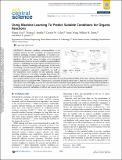| dc.contributor.author | Gao, Hanyu | |
| dc.contributor.author | Struble, Thomas J | |
| dc.contributor.author | Coley, Connor W | |
| dc.contributor.author | Wang, Yuran | |
| dc.contributor.author | Green, William H | |
| dc.contributor.author | Jensen, Klavs F | |
| dc.date.accessioned | 2021-10-27T20:29:42Z | |
| dc.date.available | 2021-10-27T20:29:42Z | |
| dc.date.issued | 2018 | |
| dc.identifier.uri | https://hdl.handle.net/1721.1/135864 | |
| dc.description.abstract | © Copyright 2018 American Chemical Society. Reaction condition recommendation is an essential element for the realization of computer-assisted synthetic planning. Accurate suggestions of reaction conditions are required for experimental validation and can have a significant effect on the success or failure of an attempted transformation. However, de novo condition recommendation remains a challenging and under-explored problem and relies heavily on chemists' knowledge and experience. In this work, we develop a neural-network model to predict the chemical context (catalyst(s), solvent(s), reagent(s)), as well as the temperature most suitable for any particular organic reaction. Trained on ∼10 million examples from Reaxys, the model is able to propose conditions where a close match to the recorded catalyst, solvent, and reagent is found within the top-10 predictions 69.6% of the time, with top-10 accuracies for individual species reaching 80-90%. Temperature is accurately predicted within ±20 °C from the recorded temperature in 60-70% of test cases, with higher accuracy for cases with correct chemical context predictions. The utility of the model is illustrated through several examples spanning a range of common reaction classes. We also demonstrate that the model implicitly learns a continuous numerical embedding of solvent and reagent species that captures their functional similarity. | |
| dc.language.iso | en | |
| dc.publisher | American Chemical Society (ACS) | |
| dc.relation.isversionof | 10.1021/ACSCENTSCI.8B00357 | |
| dc.rights | Article is made available in accordance with the publisher's policy and may be subject to US copyright law. Please refer to the publisher's site for terms of use. | |
| dc.source | ACS | |
| dc.title | Using Machine Learning To Predict Suitable Conditions for Organic Reactions | |
| dc.type | Article | |
| dc.contributor.department | Massachusetts Institute of Technology. Department of Chemical Engineering | |
| dc.relation.journal | ACS Central Science | |
| dc.eprint.version | Final published version | |
| dc.type.uri | http://purl.org/eprint/type/JournalArticle | |
| eprint.status | http://purl.org/eprint/status/PeerReviewed | |
| dc.date.updated | 2019-08-19T17:44:53Z | |
| dspace.orderedauthors | Gao, H; Struble, TJ; Coley, CW; Wang, Y; Green, WH; Jensen, KF | |
| dspace.date.submission | 2019-08-19T17:44:55Z | |
| mit.journal.volume | 4 | |
| mit.journal.issue | 11 | |
| mit.metadata.status | Authority Work and Publication Information Needed | |
